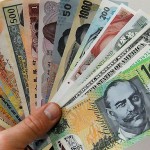On Thursday gold for delivery in April traded within the range of $1,201.60-$1,239.20. Futures closed at $1,231.40, surging 1.68% on a daily basis. It has been the 9th gain in the past 14 trading days, a second consecutive one and also the sharpest one since February 11th, when the metal added 4.45%. In addition, the daily high has been the highest price level since February 12th, when the commodity went up as high as $1,247.80 per troy ounce.
On the Comex division of the New York Mercantile Exchange, gold futures for delivery in April were edging down 0.41% on Friday to trade at $1,226.30 per troy ounce. The precious metal went down as low as $1,221.60 during early European trade, while the current daily high was at $1,233.30 per troy ounce.
Gold has recently been supported due to a strong demand for haven assets amid continuing decline in crude oil and other commodity prices.
Today gold trading may be influenced by the key report on US consumer prices. The annualized consumer inflation in the United States probably accelerated to 1.3% in January, according to market expectations, from 0.7% in December. If so, it would be the highest rate of inflation since November 2014, when the annual CPI rose 1.3%. In monthly terms, the Consumer Price Index (CPI) probably fell 0.1% in January, following another 0.1% dip in the preceding month. At the same time, the annualized core consumer inflation, which is stripped of prices of food and energy, probably remained at 2.1% for a second consecutive month in January, according to expectations. This has been the highest core inflation since July 2012. If the general CPI tends to approach the inflation objective, set by the Federal Reserve and considered as providing price stability, or a level below but close to 2%, this will usually bolster demand for the US dollar and also have a strong bearish effect on gold, as it heightens the probability of monetary policy tightening. The Bureau of Labor Statistics is to release the official CPI data at 13:30 GMT.
The CPI report is due out two days after the Minutes from the Federal Open Market Committees (FOMC) meeting held on January 26th-27th revealed that policy makers were concerned over recent disappointing reports on spending and production in the country, while also citing commodity and financial market developments and the possibility of a further slowdown in some emerging economies as factors that may potentially curb US economic activity.
Silver futures for delivery in March were little changed at $15.445 per troy ounce, after slipping to as low as $15.340 during early Asian trade. This followed two successive trading days of gains.
Daily and Weekly Pivot Levels
By employing the traditional calculation method, the daily pivot levels for gold are presented as follows:
Central Pivot Point – $1,224.07
R1 – $1,246.53
R2 – $1,261.67
R3 – $1,284.13
S1 – $1,208.93
S2 – $1,186.47
S3 – $1,171.33
By using the traditional method of calculation again, the weekly pivot levels for gold are presented as follows:
Central Pivot Point – $1,221.63
R1 – $1,278.27
R2 – $1,317.43
R3 – $1,374.07
S1 – $1,182.47
S2 – $1,125.83
S3 – $1,086.67





